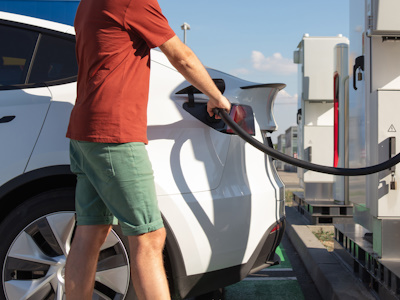In recent speeches, former President Donald Trump has repeatedly claimed that the Biden administration has spent $9 billion to build only eight electric vehicle charging stations — or even, just eight chargers. That’s not accurate.
Trump is likely referring to $7.5 billion approved by Congress to help build a network of EV chargers across the U.S. over five years. But not all of the money has been spent, or even made available to states yet. Experts say the funds are expected to help build thousands of charging stations and more than 30,000 individual charging ports.
According to the Federal Highway Administration, as of mid-August, the funds that have been deployed have helped produce 61 charging ports at 15 stations, with another 14,900 ports in progress.
Update, Dec. 9: As of Dec. 9, federal funds have been used to complete 226 charging ports at 37 stations across 13 states, with more than 24,000 ports in progress, according to an FHWA spokesperson. We asked the FHWA for the most recent information after Rep. Michael Rulli claimed on X that “Pete Buttigieg will leave his post as Transportation Secretary having spent $7.5 BILLION to build 8 EV charging stations.” A spokesperson for FHWA told us Rulli’s claim “is not true.”

Some news outlets have reported that Trump’s tone on EVs has softened a notch lately, after a July 13 endorsement from Elon Musk, chief executive of Tesla, which manufactures and sells electric cars. Yet, he has continued to spread misinformation about electric vehicle infrastructure.
On at least eight occasions in the last two months, Trump has wildly exaggerated the government’s costs of building EV chargers.
“They built eight chargers … for $9 billion! Think of them as a tank for filling up your gas. Think of it. They spent $9 billion on eight chargers! Three of which didn’t work,” Trump falsely claimed during his speech at the Republican National Convention on July 19.
At a conservative conference in Florida on July 26, Trump said it would cost the U.S. government $5 trillion to build the EV chargers at the designated locations countrywide.
Trump, July 26: I said, you know, Elon, remember, I love electric cars, I think your car is great, I love it! But it’s not for everybody. … Like sometimes you want to drive long distances, you don’t want to stop. You know, in the Midwest, someplace in the Midwest, they put up eight charging stations, you know that, right? They spent $9 billion! Now, you know what a charging station is, it’s like a gas pump, it’s the equivalent of a gas pump for electricity, right? It’s a little thing. They spent $9 billion. That would mean that if they did it throughout the country, all the locations designated, it would cost $5 trillion. So our country would have to file for bankruptcy, they would have to file bankruptcy protection to build them. The whole thing is crazy!
He recited nearly the same remarks the next day, at a rally in St. Cloud, Minnesota, except he increased the total cost to $10 trillion — and pledged to “end the Biden-Harris electric vehicle mandate on Day 1.”
More recently, in Atlanta on Aug. 5, Trump once again repeated the claim. “For eight chargers, they spent $9 billion. Is that a good deal? So at that rate, it would be $10 trillion to charge up the country,” he said.
Pete Gould, a policy expert in transportation and mobility technology and a lobbyist for the EV and charging industry, told E&E News that Trump’s calculations “sound too ridiculous to be true … because they aren’t true.”
We asked the Trump campaign about his claims, but we haven’t received a response. Trump appears to be distorting media articles about the $7.5 billion, five-year investment plan to help create an EV charging network. The funds were allocated by Congress through the Infrastructure Investment and Jobs Act signed by President Joe Biden in 2021.
On March 29, the Washington Post published a story with the headline “Biden’s $7.5 billion investment in EV charging has only produced 7 stations in two years.” Later in May, Autoweek published an article with the headline “$7.5 Billion In Federal Funds Yield Only 8 EV Charging Stations.” Both stories reported on criticism of the slow pace at which the program was rolling out — but they didn’t claim the funds were fully spent. Not all the stations were in the Midwest, either. The articles said the stations had opened in Hawaii, New York, Ohio, Pennsylvania and Vermont.
As we mentioned, the federal funding has helped build 61 charging ports at 15 stations as of mid-August, and 14,900 more ports are currently in some stage of development. Under the funding, each charging station, or location, is required to have at least four charging ports.

Michelle Levinson, senior manager of eMobility finance and policy at the World Resources Institute, told us the number of stations that are open right now represents “a small fraction of what the program is expected to accomplish” and that in “terms of awarding funding, the Biden Administration has made good progress.”
The Federal Highway Administration, which doesn’t entirely fund each project, couldn’t tell us how many charging stations or ports ultimately could be built with the $7.5 billion, because it “ultimately depends on how states and communities plan to use their funding,” a FHWA spokesperson said in an email. The new charging stations use both the federal money awarded to states and private funding.
But the EV policy analyst group Atlas Public Policy told the Washington Post in March that the $7.5 billion should be enough for “up to 20,000 charging spots or around 5,000 stations.” Nick Nigro, founder of Atlas Public Policy, told us that his group has since revised those estimates upward.
Just looking at the $5 billion program dedicated to building charging stations along major highways, Nigro said updated data from 10 states shows the government’s share of building each port is $150,000, on average. That works out to more than 30,000 ports and as many as 7,500 stations, assuming each has four ports (Nigro said the station number will likely be lower, since many stations will have more ports). Even more charging stations and ports can be built with the other $2.5 billion.
Levinson, of the World Resources Institute, told us that’s a reasonable estimation “and our experience with similar projects would yield similar numbers.”
The Biden administration’s goal is to have 500,000 chargers by 2030, with additional public and private funding. As of Aug. 14, there were 65,904 public station locations available in the U.S. with a total of 179,547 EV charging ports, according to the Joint Office of Energy and Transportation’s Alternative Fuels Data Center.
Funding Process and Progress
Of the $7.5 billion in funding, $5 billion will go to the National Electric Vehicle Infrastructure Program, which will award money to states to build chargers along the nation’s major highways, according to a statement FHWA sent us. So far, approximately $2.4 billion has been made available to all 50 states, plus D.C. and Puerto Rico. But that money hasn’t all been spent yet — and states haven’t even necessarily given out their awards. According to a National Association of State Energy Officials report, as of mid-April, 19 states had awarded $287.6 million in NEVI funds.
FHWA told us states are in various stages of deploying the funding received based on their state plans. So far, NEVI-awarded funds have resulted in the 15 operational charging stations and 61 ports across eight states. The agency said that number is expected to “grow rapidly with 28 states having announced conditional or final awards for 719 charging stations.”
In addition, approximately $623 million has been awarded for 47 projects through the Charging and Fueling Infrastructure Discretionary Grant Program, which received the remaining $2.5 billion in funding allocated by the infrastructure law, according to FHWA. The first round of funding awarded through the CFI program in fiscal years 2022 and 2023 is expected to result in approximately 7,500 EV charging ports in states and localities where people live and work, the agency said.
Finally, approximately $148.8 million was awarded in grants for 24 projects in 20 states through the Electric Vehicle Charger Reliability and Accessibility Accelerator Program, which is for states and localities that need additional help. That funding, which comes from the NEVI program, is expected “to repair or replace approximately 4,500 EV charging ports,” FHWA told us.
To access federal funds to build EV chargers, states have to submit plans to the Joint Office of Energy and Transportation each year before August, and then, if the plans are approved, solicit bids and award the funds for the work to be done.
“There is certainly still a long way to go in terms of getting the projects up and running, and we would love to see states move faster, but this is not out of line with what we expected for such a massive undertaking,” Levinson said. “Some states are further along than others, but all participants must navigate a complicated landscape of considerations such as siting and permitting challenges, ensuring adequate infrastructure is in place to handle this new technology, and tailoring projects to their communities’ unique needs. These processes can take time—it is not uncommon for it to take 2-3 years to build a new charging station—but we are encouraged to see that 36 states have released their first-round funding solicitations.”
Government officials and experts also have said that Biden’s plan has taken time to roll out because of other factors, including the creation of guidelines, new and strict standards and requirements to build these charging stations, and partnerships with states that in most cases had no previous experience with EV charging stations.
As for Trump’s claim of a Biden-Harris “electric vehicle mandate,” which he repeated at a rally in North Carolina on Aug. 14 and at a news conference in New Jersey on Aug. 15, the administration can’t mandate how many cars must be electric, as we’ve explained before.
Biden’s goal is to have EVs make up 50% of new car sales by 2030. A new Environmental Protection Agency vehicle emissions rule that limits tailpipe pollution could increase the percentage of new car sales that are EVs above Biden’s goal by 2032. Vehicle makers would be required to comply with the standards, but would have flexibility in how they meet them. For example, they could choose to make more efficient internal combustion engines for gas-powered or hybrid vehicles.
Editor’s note: FactCheck.org does not accept advertising. We rely on grants and individual donations from people like you. Please consider a donation. Credit card donations may be made through our “Donate” page. If you prefer to give by check, send to: FactCheck.org, Annenberg Public Policy Center, P.O. Box 58100, Philadelphia, PA 19102.